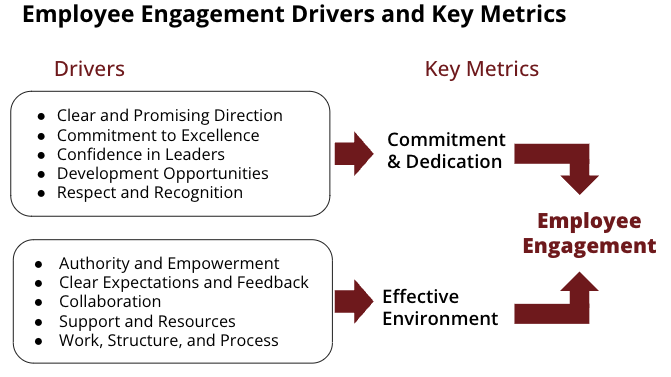At the University of Minnesota, Employee Engagement is measured by two key metrics:
- Commitment and Dedication
- Effective Environment
This is a unique approach. Measuring both key metrics allows us to identify the opportunities where we can make the most impact on engagement. This is important to understand when benchmarking against other organizations because most measure only commitment and dedication. Employees are able to thrive and continue to give their best in a work environment that supports their efforts, and University leaders have data on how best to address environmental factors.
Thank You for Making Your Voice Heard
Our Employee Engagement Survey Process
- 2023 marked 10 years since the University started conducting the Employee Engagement Surveys
- In 2023, 20,460 faculty and staff from all campuses received an invitation to participate in the survey.
- The survey has 36 questions that provide data to leaders regarding the workplace experience.
- Benefits-eligible employees share feedback via an online survey.
- Faculty and staff receive similar surveys.
- Data are gathered by a vendor partner to ensure confidentiality.
- Survey results are shared with supervisors, managers, directors, and senior leaders if five or more faculty or staff respond to their respective surveys.
Three Things to Know about Employee Engagement
- A survey alone does not create positive change. Only involving leaders, faculty, and staff in responding to survey results can create positive change in the work environment.
- Results must be shared. Disengagement begins when people who take time to respond to a survey don't hear their results from their leaders.
- Take action. A few small, simple actions can have a big impact. Let faculty and staff know when action is taken based on their survey feedback.

Key Metrics
Commitment and dedication refers to an individual’s level of personal motivation and conviction in their job. When employees are committed and dedicated to their work, they care not only about the quality of their own work but are also invested in the collective work of their group, unit, and university. This is a defining characteristic of employee engagement.
Top three questions for discussion with faculty and staff:
- Can you think of some examples where employees’ commitment and dedication were positively acknowledged?
- What motivates you to do your best work?
- How can leaders effectively motivate employees in their work?
Employees who are exerting their best efforts in their job will thrive and continue to give their best in a work environment that supports their efforts. Without an effective work environment, employees risk becoming frustrated.
Research shows that frustrated employees typically do one of three things:
- Find innovative ways around environmental barriers and become engaged;
- Get tired of challenging environmental barriers and leave the organization;
- Lower their expectations and become disengaged.
Paying attention to environmental factors is something that usually lies within a unit’s span of control and can pay big dividends in engaging employees.
Top three questions for faculty and staff:
- What could be changed to allow you to be sufficiently challenged in your work?
- How do you discuss adequate job challenges with your supervisor?
- What barriers do you encounter in trying to do your job efficiently? Which barriers are critical to your work and which are simply frustrating?